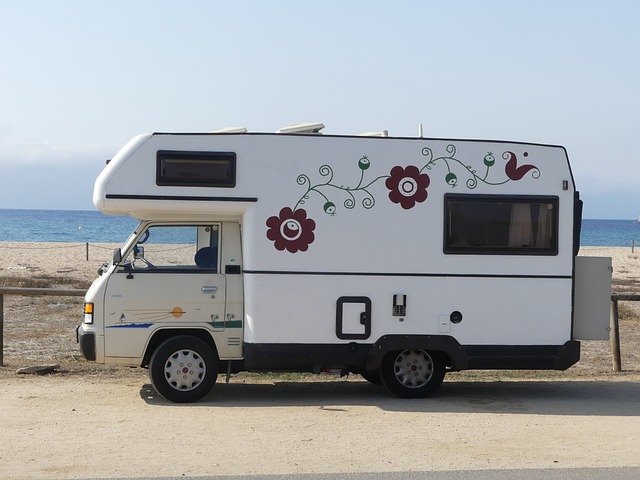When embarking on an RV journey, it's crucial to understand and manage your RV battery system effectively for a consistent power supply. The choice between deep-cycle lead-acid and lithium-ion batteries should be based on factors like cost, weight, and energy needs—lead-acid batteries are cost-effective and durable with high tolerance for frequent charging cycles, while lithium-ion batteries offer higher energy density and longevity but come at a higher price point. Proper maintenance includes regular monitoring of charge levels, avoiding full discharges, and keeping connections secure to ensure battery longevity and prevent failure during travel. A pre-trip inspection is vital to verify the battery's condition, including ensuring it's fully charged, checking for corrosion or damage, and confirming optimal electrical contact. Temperature control is paramount; batteries should be positioned in a well-ventilated area away from direct sunlight, and appropriate insulation should be used in cold conditions to maintain performance. In case of emergencies, it's essential to have alternative lighting sources, such as crank or solar-powered options, and to keep jumper cables and a toolkit handy for immediate troubleshooting. Always stay informed on safety guidelines and have roadside assistance contacts available for any unexpected battery issues while on the road. Understanding and maintaining your RV batteries is key to an enjoyable and power-reliable RV experience.
Embarking on an RV adventure requires careful planning, especially concerning your RV battery system. This article offers a comprehensive guide to maintaining and utilizing your RV batteries safely during travel. From selecting the right type of battery for your needs to understanding their functions, this guide covers it all. Learn how to perform a thorough pre-trip inspection to ensure your power supply is in prime condition. Understand the nuances of balancing loads within your RV’s electrical systems and the importance of temperature management for optimal battery performance. Furthermore, be prepared with emergency protocols should a battery failure occur. With these 10 tips for safe RV battery travel, you can confidently enjoy your journey without the worry of power predicaments.
- Understanding Your RV Battery System: Types and Functions
- Pre-Trip RV Battery Inspection: Ensuring Your Power Supply is Ready for Travel
- Balancing Loads: Strategic Use of Your RV's Electrical Systems
- Temperature Management: Keeping Your RV Batteries at Optimal Performance Levels
- Emergency Preparedness: What to Do in Case of RV Battery Failure
Understanding Your RV Battery System: Types and Functions

When embarking on RV travels, understanding your RV battery system is paramount for safe and reliable power usage. RV batteries primarily consist of deep-cycle lead-acid or lithium-ion types, each with its own characteristics and best-use scenarios. Deep-cycle lead-acid batteries are robust and cost-effective, making them a popular choice for RVs due to their ability to handle frequent discharge and recharge cycles without compromising their lifespan. On the other hand, lithium-ion batteries offer greater energy density and longevity, but come with a higher upfront cost. They are more efficient and lighter, which can be advantageous for RVs where weight and space are considerations.
In your RV, the batteries serve as the power source for everything from lighting and appliances to the refrigerator and HVAC system. It’s crucial to monitor the battery charge levels and understand how different appliances drain energy. For instance, running the air conditioner continuously can significantly deplete batteries faster than leaving them idle. Understanding the amp-hours your setup consumes allows for better management of your power reserves. To maximize the life of your RV batteries, it’s important to maintain proper charging levels and not allow them to fully discharge. Regular maintenance includes checking battery fluid levels for lead-acid batteries, ensuring connections are clean and tight, and employing a battery maintainer or solar panels for trickle charging when the RV is parked. By carefully managing your RV battery system, you can ensure that your travels are powered without interruption, enhancing the overall experience of RV living.
Pre-Trip RV Battery Inspection: Ensuring Your Power Supply is Ready for Travel

Before embarking on your RV adventure, a thorough pre-trip inspection of your RV battery is crucial for a hassle-free journey. Firstly, verify the charge level of your batteries; fully charged batteries are imperative for an efficient start and to power essential systems during transit. Use a battery tester or multimeter to check the voltage. Ensure that the battery hold-downs are secure to prevent movement and potential damage during travel. Additionally, inspect the battery terminals and cables for corrosion, wear, or looseness. Clean any corroded terminals with a baking soda paste and a brush, then apply a protective coating to prevent future corrosion. Check all connections for tightness; connectors that are too loose can lead to poor electrical contact, which might cause the battery to fail when you need it most.
Furthermore, it’s essential to examine the battery case for any cracks or bulging, as these can be indicators of overcharging or a failing cell. Ensure that all vents are clear and functional to prevent hydrogen gas accumulation, which can be dangerous. If your RV is equipped with a solar charging system or a generator, test these components to confirm they are functioning correctly and are properly connected to the battery bank. Lastly, consider the battery’s age; over time, batteries naturally degrade, and their capacity diminishes. Replacing an old battery with a new one can significantly enhance your RV’s reliability on the road. By taking these steps during your pre-trip inspection, you can ensure that your RV battery is ready for travel, providing you with the power you need for a safe and enjoyable trip.
Balancing Loads: Strategic Use of Your RV's Electrical Systems

When embarking on an extended RV journey, understanding how to balance loads within your vehicle’s electrical system is crucial for maintaining safe and efficient power usage, particularly concerning your RV battery. To start, recognize that RV batteries have a finite capacity; therefore, it’s essential to manage your energy consumption wisely. Avoid depleting your RV battery below 50% of its charge regularly, as this can shorten its lifespan. Instead, use your battery power judiciously by prioritizing necessary appliances and electronics. For instance, consider running high-demand items like air conditioners or microwaves during times when you’re connected to shore power, thus conserving your RV battery for times when you’re off-grid.
Furthermore, incorporating solar panels can significantly alleviate the strain on your RV battery by harvesting energy from the sun. This setup allows you to store excess energy in your batteries during daylight hours and use it when needed, without overworking your power source. Always monitor your battery levels with a reliable gauge or monitoring system to stay informed about your energy reserves. Additionally, insulate your batteries properly to protect them from extreme temperatures, which can also affect their performance and longevity. By strategically using your RV’s electrical systems and being mindful of your power consumption, you can ensure a safe and uninterrupted travel experience.
Temperature Management: Keeping Your RV Batteries at Optimal Performance Levels

When embarking on RV travels, maintaining your RV batteries at optimal performance levels is crucial for consistent functionality and longevity. Temperature management plays a pivotal role in preserving battery health. During hot summer months, ensure your RV batteries are installed in a well-ventilated compartment to prevent overheating. Excessive heat can lead to reduced battery life and decreased performance. Conversely, in cold conditions, the battery fluid can become viscous, slowing down the reaction necessary for energy release. To mitigate this, consider using a thermal battery blanket or installing a heating device designed for RV batteries when temperatures dip below freezing. This insulation helps maintain an optimal temperature range, typically between 60 to 75 degrees Fahrenheit (15.6 to 23.9 degrees Celsius), which is ideal for lead-acid batteries and even more critical for newer lithium or AGM types. Regularly monitoring the battery temperature with a compatible thermometer can provide peace of mind, ensuring your RV batteries are performing safely and efficiently, regardless of the external climate conditions. Additionally, charging and discharging your batteries within recommended guidelines can further enhance their performance and extend their service life, making temperature management a key aspect of RV battery care. Always refer to your specific battery manufacturer’s guidelines for precise temperature thresholds and storage recommendations.
Emergency Preparedness: What to Do in Case of RV Battery Failure

In the event of an RV battery failure, it’s crucial to have a well-thought-out emergency plan. Firstly, ensure that your RV is equipped with emergency lighting, such as flashlights and lanterns, powered by alternative energy sources like crank or solar charging, which will activate immediately when the main batteries fail. Keep these devices in easily accessible locations. Secondly, regularly maintain your RV’s batteries by checking their charge levels daily, monitoring for any signs of corrosion or damage, and understanding how to safely jump-start them if necessary. Always travel with a set of jumper cables and know the location of your RV’s battery disconnect switch in case you need to isolate the battery during an emergency. Additionally, familiarize yourself with the layout of your RV’s electrical system so that you can quickly identify and address any circuit issues. It’s also wise to have a basic toolkit on hand for minor repairs. In the event of an unexpected battery failure while traveling, stay calm and use your knowledge of the RV’s systems to troubleshoot and find a temporary solution. If the issue cannot be resolved on-site, have roadside assistance contact information readily available to call for professional help. Remember to keep all safety instructions for your RV batteries handy and review them regularly to ensure you are prepared for any situation involving RV battery failure.
When embarking on your RV adventures, remembering these 10 tips for safe RV battery travel will ensure a smooth and powered journey. From understanding your RV battery system’s types and functions to conducting a thorough pre-trip inspection, you are now equipped to manage your electrical loads strategically and maintain optimal battery performance across varying temperatures. Moreover, by being prepared for emergencies, you can confidently navigate the open road with the peace of mind that comes from knowing how to handle potential RV battery issues effectively. Safe travels!
